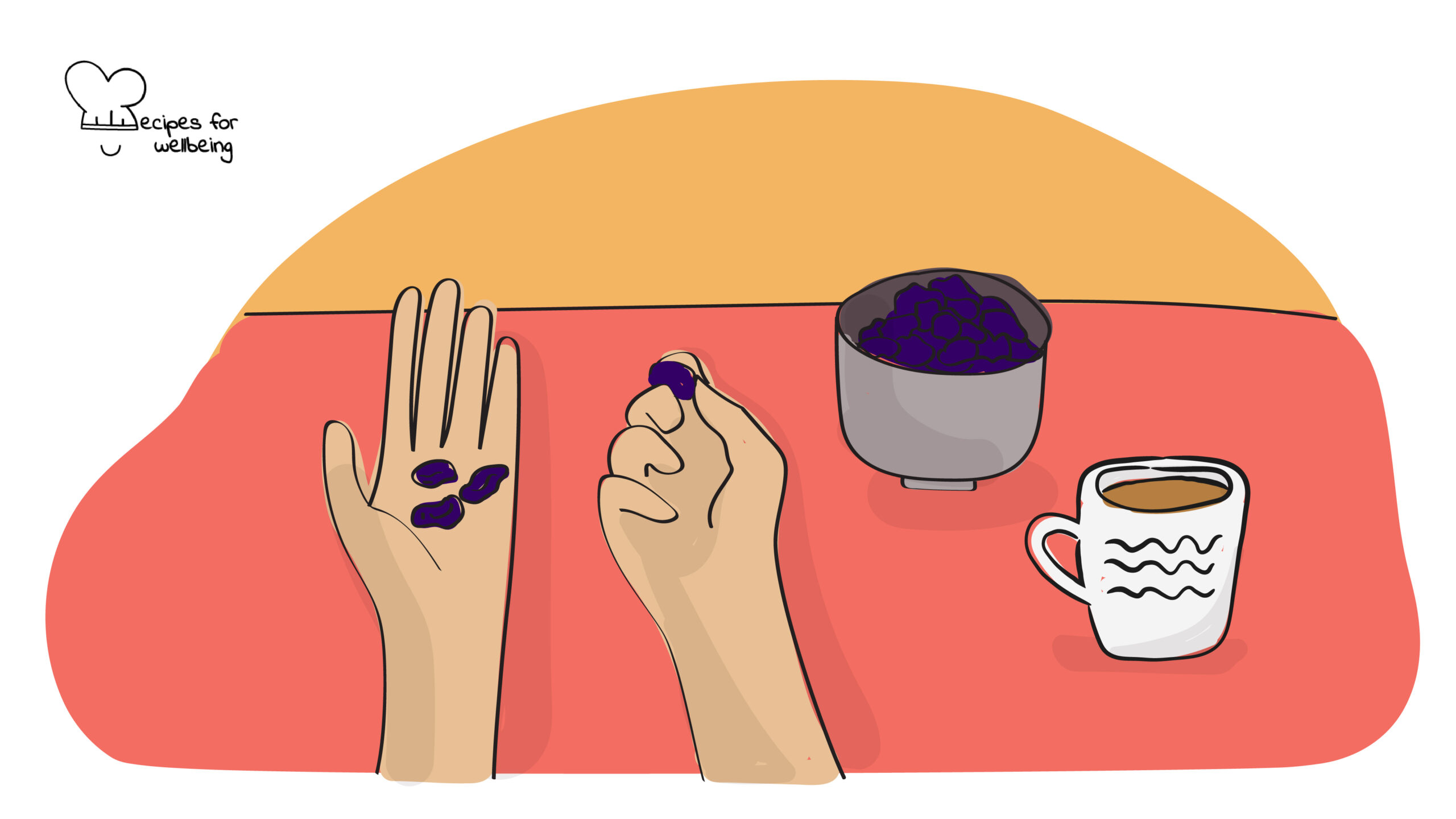
Raisin meditation
When we taste with attention, even the simplest foods provide a universe of sensory experience. ―Jon Kabat-Zinn
 Serves: 1 person, 11-25 people, 2-10 people, 26-40 people
Serves: 1 person, 11-25 people, 2-10 people, 26-40 people
 Difficulty: Easy
Difficulty: Easy
 Total time: 11-30 minutes
Total time: 11-30 minutes
 Ingredients: A quiet place with no distractions, raisins
Ingredients: A quiet place with no distractions, raisins
 Wholebeing Domains: Awareness, Positive Emotion
Wholebeing Domains: Awareness, Positive Emotion
 Wholebeing Skills: Abundance, Contemplation, Focus, Gratitude, Mindfulness, Pleasure, Presence
Wholebeing Skills: Abundance, Contemplation, Focus, Gratitude, Mindfulness, Pleasure, Presence

Raisin meditation
 Description
Description
Mindfulness through the senses.
Mindful eating is a form of mindfulness practice that has numerous benefits for your mind and body, including (1) reducing overeating and binge eating, (2) losing weight, (3) coping with chronic eating problems… And it will help you truly savour your food!
Why you should try it: “Many of us spend our lives rehashing the past or rushing into the future without pausing to enjoy the present. Distracted from the world around us, our life might feel only half-lived, as we’re too busy to savour—or even notice—everyday pleasures.
Practising mindfulness can help. Mindfulness helps us tune into what we’re sensing and experiencing in the present moment—it’s the ability to pay more careful attention to our thoughts, feelings, and bodily sensations, without judging them as good or bad. Research suggests that it can not only reduce stress but also increase our experience of positive emotions.
One of the most basic and widely used methods for cultivating mindfulness is to focus your attention on each of your senses as you eat a raisin. This simple exercise is often used as an introduction to the practice of mindfulness. In addition to increasing mindfulness more generally, this meditation can promote mindful eating and foster a healthier relationship with food. Try it with a single raisin—you might find that it’s the most delicious raisin you’ve ever eaten.”
Why it works: “By increasing awareness of internal mental and physical states, mindfulness can help people gain a greater sense of control over their thoughts, feelings, and behaviour in the present moment. Paying closer attention to the sensations of eating can increase our enjoyment of our food and deepen our appreciation for the opportunity to satisfy our hunger. Mindfulness can also help people become more attuned to hunger and fullness signals and therefore avoid overeating or “emotional eating.” In the words of mindfulness expert Jon Kabat-Zinn, ‘When we taste with attention, even the simplest foods provide a universe of sensory experience.’”
The following practice invites you to practise mindfulness through your five senses. The source is: “Eating One Raisin: A First Taste of Mindfulness.” Extension Service, West Virginia University.The instructions are adapted from: Williams, M., Teasdale, J., Segal, Z., & Kabat-Zinn, J. (2007). The Mindful Way through Depression: Freeing Yourself from Chronic Unhappiness. New York: Guilford Press. Evidence that it works can be found here: Praissman, S. (2008). Mindfulness-based stress reduction: a literature review and clinician’s guide. Journal of the American Academy of Nurse Practitioners, 20(4), 212-216. You can access this practice at the Greater Good Science Center website: https://ggia.berkeley.edu/practice/raisin_meditation.
 Steps
Steps
Step 1 – Hold
First, take a raisin and hold it in the palm of your hand or between your finger and thumb.
Step 2 – See
Take time to really focus on it; gaze at the raisin with care and full attention—imagine that you’ve just dropped in from Mars and have never seen an object like this before in your life. Let your eyes explore every part of it, examining the highlights where the light shines, the darker hollows, the folds and ridges, and any asymmetries or unique features.
Step 3 – Touch
Turn the raisin over between your fingers, exploring its texture. Maybe do this with your eyes closed if that enhances your sense of touch.
Step 4 – Smell
Hold the raisin beneath your nose. With each inhalation, take in any smell, aroma, or fragrance that may arise. As you do this, notice anything interesting that may be happening in your mouth or stomach.
Step 5 – Place
Now slowly bring the raisin up to your lips, noticing how your hand and arm know exactly how and where to position it. Gently place the raisin in your mouth; without chewing, noticing how it gets into your mouth in the first place. Spend a few moments focusing on the sensations of having it in your mouth, exploring it with your tongue.
Step 6 – Taste
When you are ready, prepare to chew the raisin, noticing how and where it needs to be for chewing. Then, very consciously, take one or two bites into it and notice what happens in the aftermath, experiencing any waves of taste that emanate from it as you continue chewing. Without swallowing yet, notice the bare sensations of taste and texture in your mouth and how these may change over time, moment by moment. Also pay attention to any changes in the object itself.
Step 7 – Swallow
When you feel ready to swallow the raisin, see if you can first detect the intention to swallow as it comes up, so that even this is experienced consciously before you actually swallow the raisin.
Step 8 – Follow
Finally, see if you can feel what is left of the raisin moving down into your stomach, and sense how your body as a whole is feeling after you have completed this exercise.
Step 9 – Share (15’)
If in a group, give participants time to share about their experience: What did they discover about the raisin? Which sense was the strongest? How did their body respond to different cues? What did they learn about themselves and the raisin?


 Arabic
Arabic Chinese (Simplified)
Chinese (Simplified) Dutch
Dutch English
English French
French German
German Italian
Italian Portuguese
Portuguese Russian
Russian Spanish
Spanish